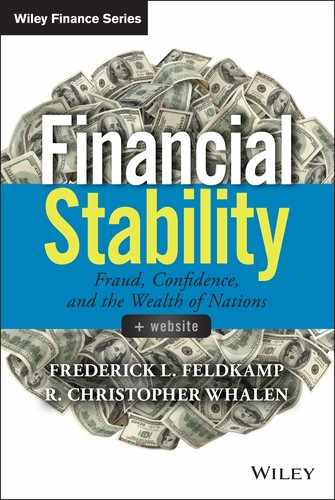CHAPTER 16
Economics: Savings ≡ Investment
It is an axiom of economics that savings must equal investment. That is to say, the total capital goods of a nation (or the world) must necessarily equal the sum total of all public and private indebtedness and equity.
In 2005, capital goods in the United States totaled roughly $100 trillion. Total reported debt was about $50 trillion, and total equity was the remaining $50 trillion. For the world, each category was roughly double the U.S. total.
Where did the shadow banking market, off-balance sheet liabilities, fit into this axiom? In the United States, that category was said to total $30 trillion (for the world, $67 trillion).
The crisis began when some financial institutions reported in 2007 that they would not honor off-balance sheet liabilities. That’s when the investors who had put cash into shadow banking funds began to flee the markets. It did not take long for all investors to question the value of equity by applying the axiom governing the relationship between capital goods and investment. If reported U.S. debt was in fact understated by $30 trillion—and worldwide debt by some $67 trillion—then equity had to be $20 trillion instead of $50 trillion in the United States and $33 trillion instead of $100 trillion worldwide. This realization that the assets and liabilities of the world economy were mismatched was the key catalyst for the financial crisis.
A massive oops occurred. This realization was equivalent to shooting a howitzer across the bow of the investment ship. Every investor with a model that produced the standard results shown in Table 9.1 would have noted the same relatively close correlation. If $30 trillion of shadow banking liabilities are added to reported debt, equity values must fall by $30 trillion, or some 60 percent. The experienced loss correlates directly to that assumption when base rates fell to 1 percent and spreads widened to Armageddon levels.
In that scenario, of course, the assets one would want to hold would be cash or Treasury debt that was, if still available, at a maturity that would allow the investor to ride out the storm obviously coming as more and more investors got it.
Smart investors knew equity was headed for a 60 percent drop in the United States and 67 percent worldwide. If one takes into account the time for a total collapse to occur, what investors saw in 2007 is exactly what had occurred by March 2009. The tragedy that began with Mr. Paulson’s announcement of a Super SIV to rescue Citigroup and other TBTF banks took 13 months to reach the climactic credit-spread spike of September–November 2008. The precise predictions of Irving Fisher in his 1933 Econometrica article came true.
The world fell into debt-contraction deflation. It was saved from the debt deflation result by replacing unsustainable private-sector debt with public-sector debt at rates low enough to support greater equity values over time, which allows a later return to private sector debt.
Under the theory of financial stability, this means we can completely recover if market policies are adopted that allow private-sector participants to refund the Fed’s public-sector bridge loans with private-sector substitutes that sustain a renewed period of economic expansion. The theory is, therefore, supported by the laws of economics.
